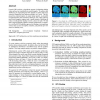Free Online Productivity Tools
i2Speak
i2Symbol
i2OCR
iTex2Img
iWeb2Print
iWeb2Shot
i2Type
iPdf2Split
iPdf2Merge
i2Bopomofo
i2Arabic
i2Style
i2Image
i2PDF
iLatex2Rtf
Sci2ools
SIGGRAPH
2010
ACM
2010
ACM
Reducing shading on GPUs using quad-fragment merging
Current GPUs perform a significant amount of redundant shading when surfaces are tessellated into small triangles. We address this inefficiency by augmenting the GPU pipeline to gather and merge rasterized fragments from adjacent triangles in a mesh. This approach has minimal impact on output image quality, is amenable to implementation in fixed-function hardware, and, when rendering pixel-sized triangles, requires only a small amount of buffering to reduce overall pipeline shading work by a factor of eight. We find that a fragment-shading pipeline with this optimization is competitive with the REYES pipeline approach of shading at micropolygon vertices and, in cases of complex occlusion, can perform up to two times less shading work. CR Categories: I.3.1 [Computer Graphics]: Hardware architecture—Graphics processors
| Added | 28 Jul 2010 |
| Updated | 29 Jul 2010 |
| Type | Conference |
| Year | 2010 |
| Where | SIGGRAPH |
| Authors | Kayvon Fatahalian, Solomon Boulos, James Hegarty, Kurt Akeley, William R. Mark, Henry Moreton, Pat Hanrahan |
Comments (0)

